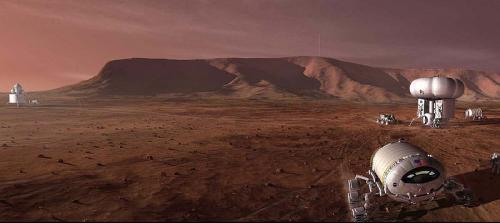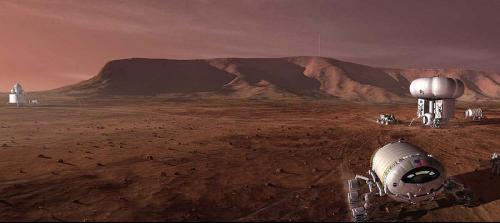
Scientists have invented a new device that can harvest CO2 in a way so as to empower life on Mars. The research plans a kind of engine to facilitate production of energy through Leidenfrost effect, a phenomenon that occurs when a liquid comes in direct contact with a hot surface even hotter than boiling point. This research was published in “Nature Communication” journal.
The effect is commonly applicable on water, but it also applies to dry ice, another name for solid carbon dioxide. As a result of the phenomenon, Carbon Dioxide floats above the hot surface because of the presence of a protective barrier formed by evaporated gas vapour. The vapour generated by dry ice creates adequate pressure that overcomes the gravity, which in turn lifts the disc from the surface through Leidenfrost. Based on this vapour, the engine was invented as a method for harvesting energy. The Leidenfrost-based engines are comparatively better than steam-based heat engines, as the former creates less friction. It is a well-known fact that Mars possesses extremely harsh climate. According to NASA's Mars Reconnaissance Orbiter (MRO), solid carbon dioxide might be naturally available at Mars. According to a satellite image, the surface of Mars is filled with large gullies that is nearly 2km in length. These structures are much different than water gullies at Earth.
NASA's Mars Reconnaissance Orbiter (MRO) suggests that solid CO2 may be a naturally occurring resource on Mars, based on the seasonal appearance of gullies on the surface of the Red Planet. The role of CO2 in Mars is exactly similar to water’s importance on earth. Hence CO2 is a freely available source at Mars which experiences changes in cyclical phase, under the impact of seasonal variation that changes Martian temperature. Mars is considered as the future source of power generation, which will facilitate harvesting of energy or extracting chemical energy through methane gas.
However, the research points that CO2 is very promising in order to sustain life in Mars. It is certain that human’s future on other planets are highly dependent upon the adapting capability and devise unique methods to exploit natural resources that are not available on earth.
The unique and less frictional characteristics of the engine will create remarkable implications and probably make the space exploration and colonization sustainable in the long-term. This is just an initiation towards the thrilling path of research in material engineering. In the future, the Leidenfrost based engines can be utilized in varied range of applications from different fields such as from less friction conveyance to space exploration.
The energy industry is encountering a key issue of finding a method to store electricity to use when demand is maximum. One of the major challenges for science in today’s world will be discovering new methodologies to harvest energy, particularly, in extreme environments.
The effect is commonly applicable on water, but it also applies to dry ice, another name for solid carbon dioxide. As a result of the phenomenon, Carbon Dioxide floats above the hot surface because of the presence of a protective barrier formed by evaporated gas vapour. The vapour generated by dry ice creates adequate pressure that overcomes the gravity, which in turn lifts the disc from the surface through Leidenfrost. Based on this vapour, the engine was invented as a method for harvesting energy. The Leidenfrost-based engines are comparatively better than steam-based heat engines, as the former creates less friction. It is a well-known fact that Mars possesses extremely harsh climate. According to NASA's Mars Reconnaissance Orbiter (MRO), solid carbon dioxide might be naturally available at Mars. According to a satellite image, the surface of Mars is filled with large gullies that is nearly 2km in length. These structures are much different than water gullies at Earth.
NASA's Mars Reconnaissance Orbiter (MRO) suggests that solid CO2 may be a naturally occurring resource on Mars, based on the seasonal appearance of gullies on the surface of the Red Planet. The role of CO2 in Mars is exactly similar to water’s importance on earth. Hence CO2 is a freely available source at Mars which experiences changes in cyclical phase, under the impact of seasonal variation that changes Martian temperature. Mars is considered as the future source of power generation, which will facilitate harvesting of energy or extracting chemical energy through methane gas.
However, the research points that CO2 is very promising in order to sustain life in Mars. It is certain that human’s future on other planets are highly dependent upon the adapting capability and devise unique methods to exploit natural resources that are not available on earth.
The unique and less frictional characteristics of the engine will create remarkable implications and probably make the space exploration and colonization sustainable in the long-term. This is just an initiation towards the thrilling path of research in material engineering. In the future, the Leidenfrost based engines can be utilized in varied range of applications from different fields such as from less friction conveyance to space exploration.
The energy industry is encountering a key issue of finding a method to store electricity to use when demand is maximum. One of the major challenges for science in today’s world will be discovering new methodologies to harvest energy, particularly, in extreme environments.


















